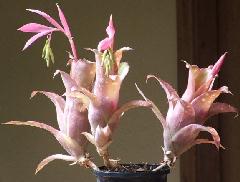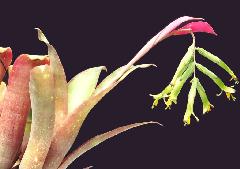

Let us now move on to ‘Purple Haze’ which is a bit of an enigma because it had a few spots on the leaves which would link it to var. maculata but sometimes not, which would link it to var. distachia. In Flora Neotropica, Smith only quotes var. maculata as having flavous spotted leaves but in 1983 Reitz who originally described var. maculata said it had blue tipped sepals and petals. ‘Purple Haze’ has blue tipped sepals and petals. In the 1970’s Olwen Ferris was selling B. distachia var. straussiana described as “medium small, grey-white vase flushed lavender. Pink bracts, blue petals on pendant spike” but decided to call it ‘Purple Haze’ probably because she realised her plant did not have totally green petals. Nothing was written about the change of name and the name was not registered. In the 1980’s ‘Purple Haze’ was in several nurseryman’s plant lists.
I now go back to 1964 when I think this ‘Purple Haze’ originated coming to Bill Morris as B. bakeri.
Billbergia distachia by Bill Morris in Bromeletter(1)7: 1964
“In Dr. L B Smith’s Bromeliaceae of Brazil, 4 botanical varieties are listed, var. distachia, var. straussiana; var. concolor; var. maculata. The first 3 are described as having the leaves concolorous whilst var. maculata has leaves “flavous spotted” (pale yellow). The varieties straussiana (sepals blue at apex) and concolor (sepals wholly green) both have flowers with green petals, whereas the other two have petals tipped with blue.
I have raised B. distachia seed from Santa Catarina, Brazil as well as from other sources and some of these plants are quite interesting. Firstly the Brazilian seed labelled B. distachia has produced mainly plants with fat stubby tubes about 2” in diam., at their widest and 10-12” high. These plants vary from almost glabrous to moderately scurfy; the leaves are mostly green to green yellow with an occasional white spot.
One or two plants have occurred which are quite pigmented and produce a beautiful red plant and could be the horticultural variety named in the USA as var. ‘Rubra’. Again an occasional plant has been quite heavily spotted with cream spots and would fit var. maculata.
I obtained from one of the Australian Soc. Members in Qld, two very beautiful plants labelled B. distachia var. maculata quite heavily spotted cream ( but no more so than the seedlings already mentioned) and also deeply pigmented. These red spotted plants are most attractive.
Another batch of seedlings that I raised, came from a Botanical garden in Germany labelled B. bakeri. This is listed by L B Smith as a synonym of B. distachia which it certainly is; however, all the seedlings can be easily separated from the Brazilian plants as they are completely silvery and pigmented with pink and red shades, and much more desirable to the horticulturalist than the natural species. I say this because I feel that the German type could have been produced by selection from the red, somewhat scaly forms mentioned earlier, but this is only guesswork on my part.
There are two more plants worth mentioning, one labelled B. ensifolia and the other B. regeliana, both names listed by Smith as synonyms of B. distachia. I have not flowered B. regeliana so cannot be sure it is a form of B. distachia but it produces the smallest tubes of any Billbergia I have seen, being often no more than 6” high and 1/2” wide, or smaller. The largest I have seen would be 8” X 1/2” . The plant is tightly clustering and not easy to grow.
B. ensifolia has flowered on a number of occasions and is B. distachia with the growth of the plant quite different from the rest. It is much like a tight form of B. nutans, being widest in the middle of the tube (up to 1” diam) and narrower both above and below. The leaves finally separate at the top and are much narrower and drawn out to a long narrow point. This characteristic is quite constant under my conditions (unlike B. nutans, the tube of which varies according to conditions). I haven’t flowered enough seedlings to be able to observe flower colour/variations, if any."
I have therefore decided to get the ‘Purple Haze’ registered. 1964 was when mainly species were grown and from what Bill Morris said then, we had quite a range within this species.
To those of you who still grow species would you please check your collections, and, using the differences that Bill used 45 years ago, please photo flowering plants this coming ‘winter’ and send them to me for the records.
Acknowledgements
Thanks to Peter Franklin and Kent Jacobsson for helping me get somewhere near the truth.
